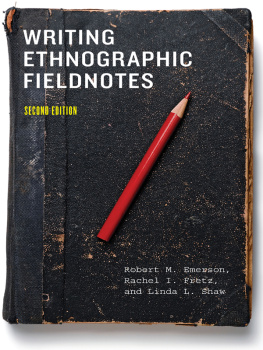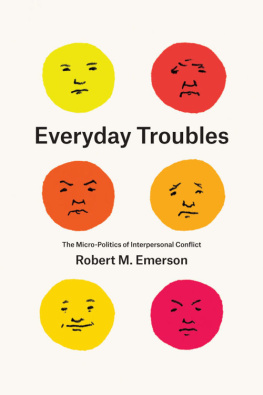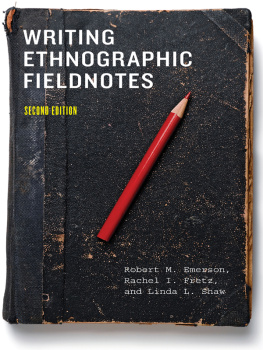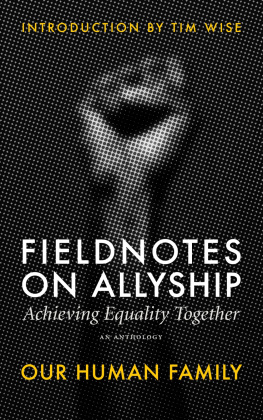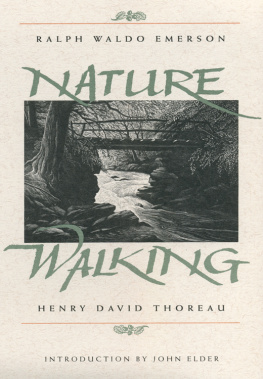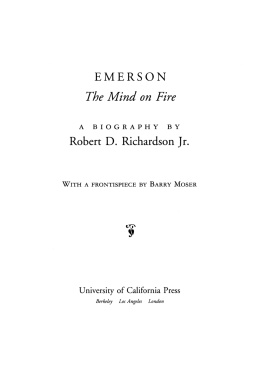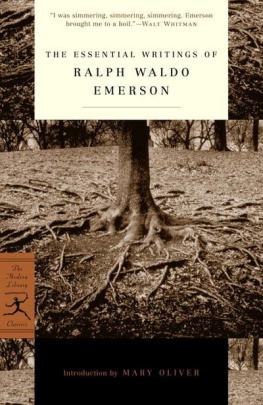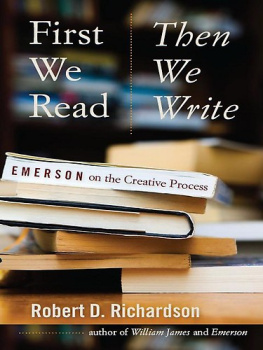Robert M. Emerson - Writing Ethnographic Fieldnotes
Here you can read online Robert M. Emerson - Writing Ethnographic Fieldnotes full text of the book (entire story) in english for free. Download pdf and epub, get meaning, cover and reviews about this ebook. year: 2011, publisher: University of Chicago Press, genre: Romance novel. Description of the work, (preface) as well as reviews are available. Best literature library LitArk.com created for fans of good reading and offers a wide selection of genres:
Romance novel
Science fiction
Adventure
Detective
Science
History
Home and family
Prose
Art
Politics
Computer
Non-fiction
Religion
Business
Children
Humor
Choose a favorite category and find really read worthwhile books. Enjoy immersion in the world of imagination, feel the emotions of the characters or learn something new for yourself, make an fascinating discovery.
- Book:Writing Ethnographic Fieldnotes
- Author:
- Publisher:University of Chicago Press
- Genre:
- Year:2011
- Rating:5 / 5
- Favourites:Add to favourites
- Your mark:
- 100
- 1
- 2
- 3
- 4
- 5
Writing Ethnographic Fieldnotes: summary, description and annotation
We offer to read an annotation, description, summary or preface (depends on what the author of the book "Writing Ethnographic Fieldnotes" wrote himself). If you haven't found the necessary information about the book — write in the comments, we will try to find it.
Writing Ethnographic Fieldnotes — read online for free the complete book (whole text) full work
Below is the text of the book, divided by pages. System saving the place of the last page read, allows you to conveniently read the book "Writing Ethnographic Fieldnotes" online for free, without having to search again every time where you left off. Put a bookmark, and you can go to the page where you finished reading at any time.
Font size:
Interval:
Bookmark:
ROBERT M. EMERSON is professor emeritus in the Department of Sociology at the University of California, Los Angeles. He is the author of Contemporary Field Research: Perspectives and Formulations, now in its second edition. RACHEL I. FRETZ is a lecturer in the Writing Programs unit at UCLA. LINDA L. SHAW is professor in and chair of the sociology department at California State University, San Marcos.
The University of Chicago Press, Chicago 60637
The University of Chicago Press, Ltd., London
1995, 2011 by The University of Chicago
All rights reserved. Published 2011.
Printed in the United States of America
20 19 18 17 16 15 14 13 12 11 1 2 3 4 5 6 7 8 9
ISBN-13: 978-0-226-20683-7 (paper)
ISBN-10: 0-226-20683-1 (paper)
ISBN-13: 978-0-226-20686-8 (e-book)
Library of Congress Cataloging-in-Publication Data
Emerson, Robert M.
Writing ethnographic fieldnotes / Robert M. Emerson, Rachel I. Fretz, Linda L. Shaw. 2nd ed.
p. cm. (Chicago guides to writing, editing, and publishing)
ISBN-13: 978-0-226-20683-7 (pbk.: alk. paper)
ISBN-10: 0-226-20683-1 (pbk.: alk. paper)
1. EthnologyAuthorship. 2. EthnologyFieldwork. 3. EthnologyResearch. 4. Academic writing. I. Fretz, Rachel I. II. Shaw, Linda L. III. Title.
GN307.7.E44 2011
808.066305dc22
2011016145
 This paper meets the requirements of ANSI/NISO Z39.48-1992 (Permanence of Paper).
This paper meets the requirements of ANSI/NISO Z39.48-1992 (Permanence of Paper).
ETHNOGRAPHIC
FIELDNOTES
SECOND EDITION
Robert M. Emerson
Rachel I. Fretz
Linda L. Shaw

WRITING
ETHNOGRAPHIC
FIELDNOTES
SECOND EDITION

On Writing, Editing, and Publishing
Jacques Barzun
Telling about Society
Howard S. Becker
Tricks of the Trade
Howard S. Becker
Writing for Social Scientists
Howard S. Becker
Permissions, A Survival Guide
Susan M. Bielstein
The Craft of Translation
John Biguenet and Rainer Schulte, editors
The Craft of Research
Wayne C. Booth, Gregory G. Colomb, and Joseph M. Williams
The Dramatic Writers Companion
Will Dunne
Glossary of Typesetting Terms
Richard Eckersley, Richard Angstadt, Charles M. Ellerston, Richard Hendel, Naomi B. Pascal, and Anita Walker Scott
Writing Ethnographic Fieldnotes
Robert M. Emerson, Rachel I. Fretz, and Linda L. Shaw
Legal Writing in Plain English
Bryan A. Garner
From Dissertation to Book
William Germano
Getting It Published
William Germano
The Craft of Scientific Communication
Joseph E. Harmon and Alan G. Gross
Storycraft
Jack Hart
A Poets Guide to Poetry
Mary Kinzie
The Chicago Guide to Collaborative Ethnography
Luke Eric Lassiter
How to Write a BA Thesis
Charles Lipson
Cite Right
Charles Lipson
The Chicago Guide to Writing about Multivariate Analysis
Jane E. Miller
The Chicago Guide to Writing about Numbers
Jane E. Miller
Mapping It Out
Mark Monmonier
The Chicago Guide to Communicating Science
Scott L. Montgomery
Indexing Books
Nancy C. Mulvany
Developmental Editing
Scott Norton
Getting into Print
Walter W. Powell
The Subversive Copy Editor
Carol Fisher Saller
A Manual for Writers of Research Papers, Theses, and Dissertations
Kate L. Turabian
Students Guide for Writing College Papers
Kate L. Turabian
Tales of the Field
John Van Maanen
Style
Joseph M. Williams
A Handbook of Biological Illustration
Frances W. Zweifel
To our friend and colleague, Mel Pollner (19402007)
Over the past twenty-five years or so, ethnography has become a widely recognized and generally accepted approach to qualitative social research. But ironically, in the years since the publication of the first edition of Writing Ethnographic Fieldnotes in 1995, the surge of interest in ethnographic writing we noted at that time seemingly has receded. Sociologists and anthropologists no longer take up the complexities of representation in ethnography as frequently as they did in the 1980s and 1990s; they offer fewer considerations of the nature and effects of writing in ethnographic research than in those decades, although these issues seem to remain lively concerns in community studies and writing programs. But the earlier concern with the processes of writing fieldnotes, as opposed to polished ethnographic articles and monographs, does appear to have made significant marks on the practice of ethnography: Some ethnographers now publish articles on key issues and processes in writing fieldnotes, including Warren (2000) and Wolfinger (2002). In addition, and probably more significantly, some ethnographic anthologies (e.g., Atkinson, Coffey, Delamont, Lofland, and Loflands Handbook of Ethnography) and qualitative research guides (e.g., Lofland, Snow, Anderson, and Lofland, Analyzing Social Settings, fourth edition; Warren and Karner, Discovering Qualitative Methods: Field Research, Interviews, and Analysis, second edition) now provide extended discussions of how to produce and work with fieldnotes. These developments provide some indication that addressing policies and practices for writing fieldnotes is increasingly part of ethnographic training for many social scientists.
These developments provide part of the motivation for a second edition of Writing Ethnographic Fieldnotes. But our own experiences teaching ethnographic fieldwork to another generation of students played a much larger role in this decision. As we continued to work with both undergraduate and graduate students in fieldwork courses, we were struck again and again by the pivotal role that writing fieldnotes plays in introducing ethnography and in molding and deepening students research experiences. And we remain intrigued by the varieties of writing issues that students have to grapple with and try to resolve in order to create lively, detailed, and accurate fieldnote depictions of the social worlds they are trying to comprehend.
Teaching in large part from Writing Ethnographic Fieldnotes had another effect: As the result of continuing student questions and confusion, we saw at close hand some of the limitations in parts of the book. These student reactions led us to make changes at a number of points in the text, although we have tried to retain as much continuity as possible with the first edition. In particular, we have substantially reorganized on strategies and tactics for writing fieldnotes to more closely mirror the sequencing of stages through which beginning ethnographers pass in learning to write fieldnotes. In these chapters, we deepened our discussion of point of view, in particular, focusing on the shifts between first and third person as well as showing the benefits of writing in focused third person. We also clarified the many ways that fieldnote writing is a kind of narrating, both in creating a loosely structured days entry and in composing more cohesive fieldnote tales within those entries. We have made fewer and less drastic changes in the other chapters, although we have provided a fuller discussion of the issues of race, class, and gender as well as the relationship of fieldnotes and ethnography to broader social patterns and structures. Throughout, we have updated our references to reflect contributions to ethnographic practice since the publication of the first edition and included new student fieldnote excerpts that exemplify our concerns and recommendations.
Next pageFont size:
Interval:
Bookmark:
Similar books «Writing Ethnographic Fieldnotes»
Look at similar books to Writing Ethnographic Fieldnotes. We have selected literature similar in name and meaning in the hope of providing readers with more options to find new, interesting, not yet read works.
Discussion, reviews of the book Writing Ethnographic Fieldnotes and just readers' own opinions. Leave your comments, write what you think about the work, its meaning or the main characters. Specify what exactly you liked and what you didn't like, and why you think so.

